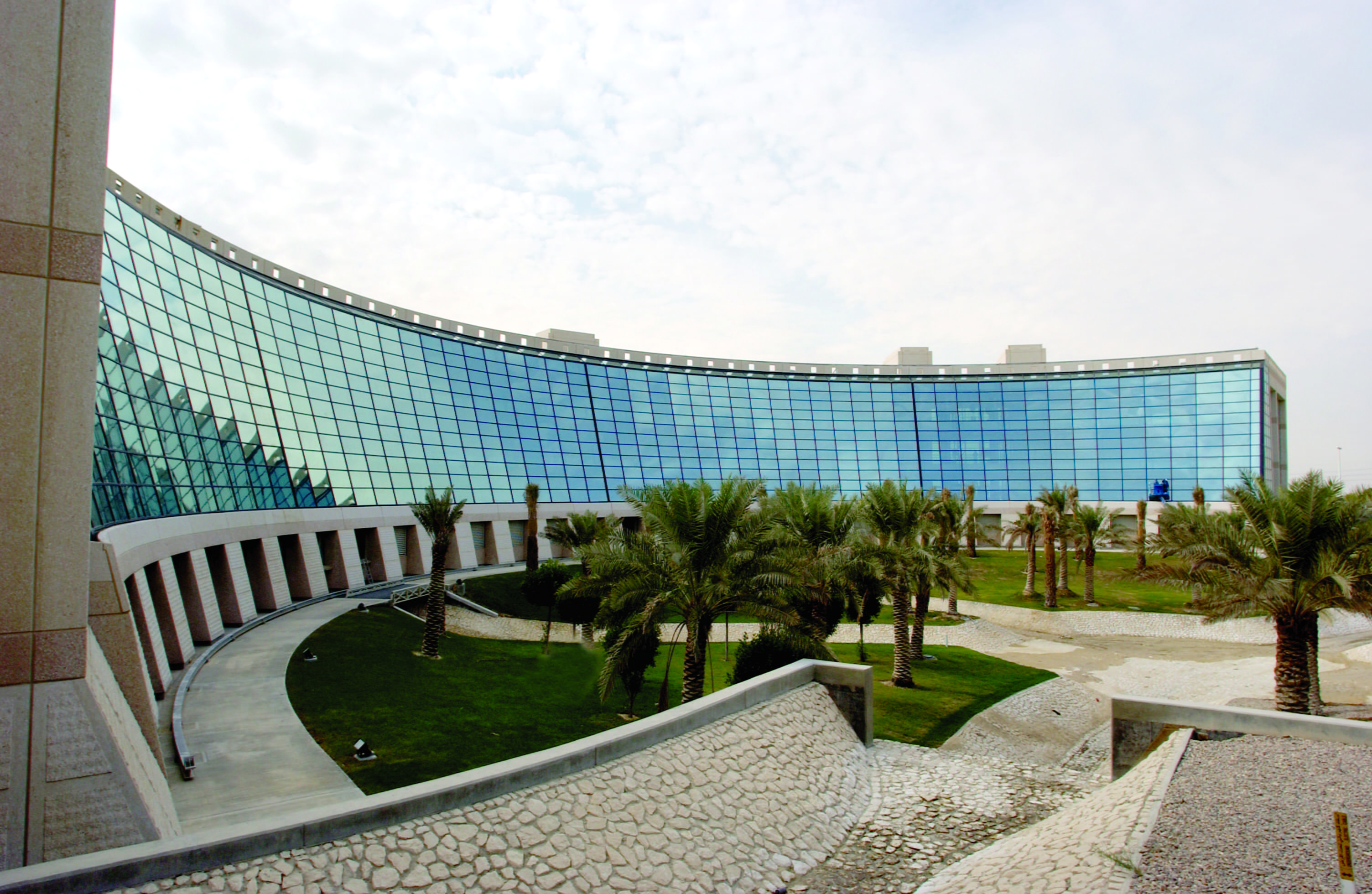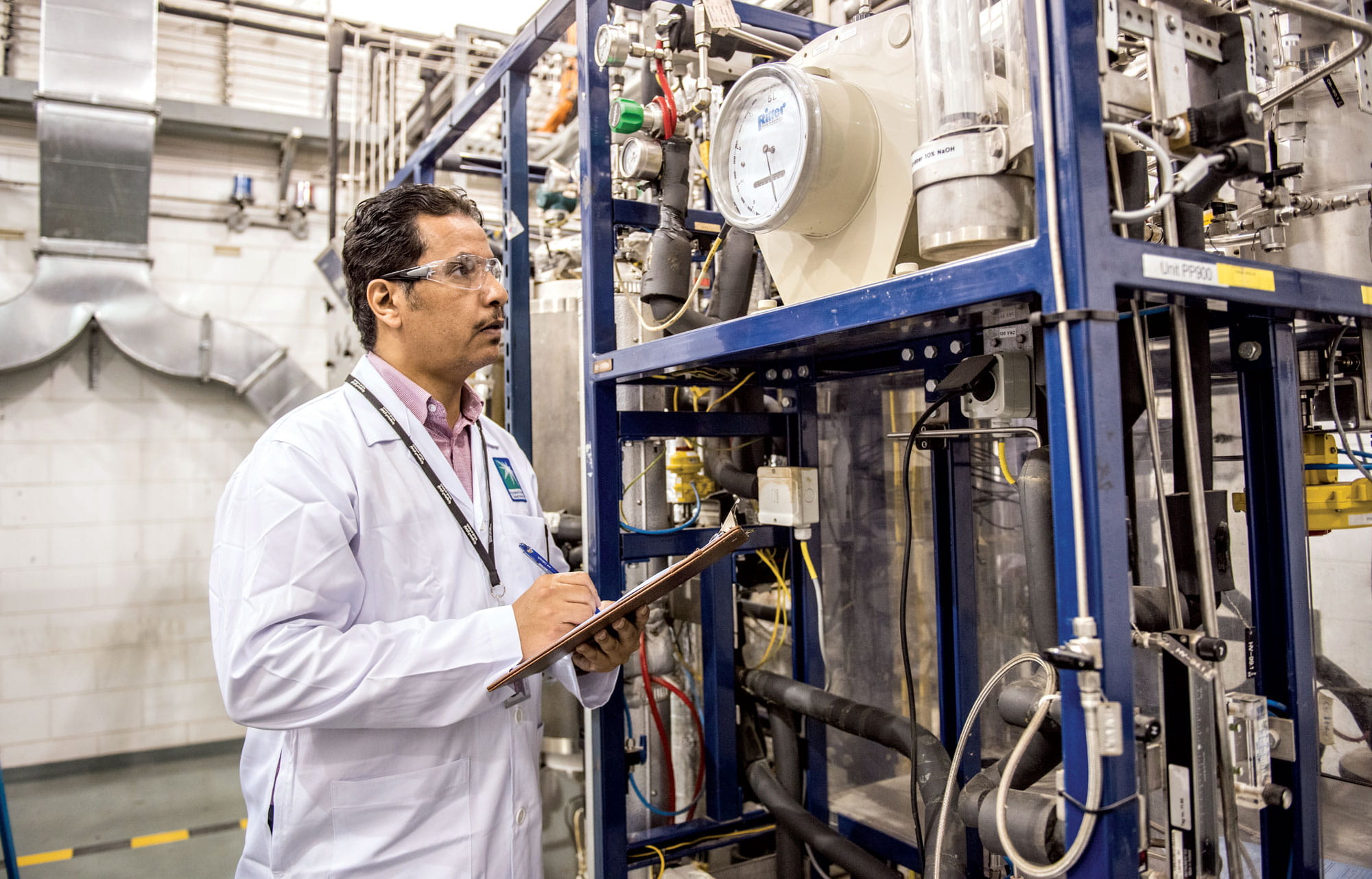
Crude oil to chemicals
Together with SABIC in our family of companies, Aramco is working to commercialize innovative crude to chemicals (CO2) technologies, positioning us as a preeminent player in the global petrochemicals industry.
Our C2C technologies aim to remove or streamline several conventional industrial processes, resulting in chemicals that are less expensive to produce while at the same time reducing the carbon footprint associated with this use of our oil.
For those who dwell outside the chemicals world, the program’s objective sounds relatively simple — the direct and optimized conversion of crude oil to chemicals. But chemical engineers and chemists know the reality behind this seemingly straightforward proposition. And at the Research and Development Center (R&DC) in Dhahran, our scientists are determined to break new ground.
Research hub
Inside R&DC, the expansive research facility at our Dhahran headquarters, our scientists are busy at work. Some are engrossed in fuel technology research, while others are immersed in optimizing the combustion engines of the future.
Whiteboards are covered in complex formulas — the inner thoughts of some of our brightest minds. With a diverse research agenda spanning sustainability, midstream and downstream, here technology moves fast.
To help reach our C2C goal a host of collaborations, acquisitions, and joint ventures have already taken place. In parallel, an ambitious technology strategy is in full swing at the center.

The Research and Development Center located at our headquarters in Dhahran, Saudi Arabia.
We are breaking new ground by unraveling the chemistry behind crude oil composition and conversion into chemicals.
“This is truly pioneering research where we are taking crude oil and looking at the shortest and most optimal pathways to derive chemicals directly through breakthroughs in catalyst and separation devices,” says Ammar A. Al Nahwi, R&DC manager.
“We are targeting 70 to 80% of each barrel of crude oil being converted to chemicals in a competitive manner. We are demonstrating clear technology leadership in this field.”
Ammar A. Al Nahwi, R&DC manager
The current process
Typically processed in an oil refinery, crude oil is transformed into a variety of fractions such as naphtha, diesel, kerosene, gas oil, and high boiling residue.
Some of these fractionated products are then used as feedstocks for conventional petrochemical production. But it’s costly. The process requires substantial, expensive, and energy-intensive refining steps.
One approach to improve the process is by optimally integrating current refining processes to yield more chemical products per barrel of oil. This involves tweaking existing proven technologies and processes in an integrated refining complex to raise the chemical production level per barrel of oil from the regular 8% to 12%, up to 50%.
The Saudi Aramco and SABIC crude oil to chemicals partnership is a good example of this approach. But what if the yield could be increased even more with fewer processes?

Scientist Kareemuddin M. Shaikh checks the pressure control valve for the pilot plant used for oneof the crude to chemicals technologies.
To crack the code, our engineers and scientists are pursuing multiple research strategies and technologies with a research focus on thermal and catalytic routes to convert crude oil to chemicals. Each research track has its own special qualities and intricacies, and is at a different stage in the development process.
“Each research track will give us a different technology option,” notes Ibrahim A. Abba, principal scientist and chief technologist for the Chemicals Research and Development Division.
“By pursuing multiple research tracks, we are diversifying our options and offering the company the most opportunities possible in the future as these technology options cover different crude types, product slates, timelines, and varying capital intensities.”
Abba leads a team of 80 scientists and engineers. As chief technologist for the program, his role involves providing technical direction and coordinating the activities of the different research tracks, as well as establishing international partnerships, including those with our global research centers around the world.
“We are working closely with our colleagues at the Boston Research Center, which specializes in catalysis and advanced materials, to explore additional novel catalyst options that complement our efforts in Dhahran,” says Abba. “We are fortunate today to have built a truly capable global network of talent, which is vital for our success in such an ambitious undertaking.”
Partnering for success
Of the research tracks, the most advanced is the Thermal Crude to Chemicals (TC2CTM) program.
Saudi Aramco has already entered into a Joint Development Agreement with U.S.-based leading technology provider CB&I (now McDermott) and Chevron Lummus Global to further accelerate the development and demonstration of the technology.
This collaboration will substantially accelerate this technology toward commercialization and our team is working to demonstrate the technology on a larger scale at CLG’s Richmond Technology Center.

At one of the C2C laboratories, lab technician Duhaiman U. Yami monitors the wet test gas meter on a pilot plant for the crude conditioning step of the Thermal Crude to Chemicals research track.
To the C2C team, two key factors are critical in ensuring the success of the program – internal support and global partnering. Partnerships from within the company, particularly with the Chemicals business are crucial. Alignment with them in terms of technology, engineering, and economics is critical as the process moves forward.
Global partnering is key. By leveraging other facilities and knowledge, we can compress our timelines and optimize our work, while at the same time, build lasting relationships that will enhance our business.
In pursuit of the catalyst
The common theme that binds the different research tracks in C2C together is the pursuit of the catalyst. This is the elixir that makes it all happen.
The purpose of the catalyst is to mix in with the hydrocarbons and initiate the reactions that lead to the production of chemicals and it’s at the core of the research being carried out at R&DC.
“In the labs, we tailor our catalysts so we can maximize ethylene and propylene,” says scientist Gopal Juttu, referring to his work on the catalytic C2C stream.
He spends his day with his research colleagues as they experiment with various compositions of the catalyst. “In addition to chemical reactivity, we also have to get the correct shape and strength of the catalyst before we evaluate its performance,” he adds.
“Imagine you are making food and the recipe has many ingredients,” explains Juttu. “You start with the main ingredient, in our case zeolite, then add extra ingredients to get the desired flavor and texture.”
This has led to the team collaborating with a number of leading universities to create test labs to optimize and monitor performance of the catalyst — another example of successful collaboration.

Ola Ali is working with the KAUST research team on developing a catalyst that can convert crude oilto chemicals in one step.
Of all the research tracks in the C2C program, the most ambitious is being conducted in conjunction with the King Abdullah University of Science and Technology (KAUST). Aramco scientist Ola Ali, who is located at the company’s research center at KAUST, is pursuing the Holy Grail in C2C research — creating a catalytic process that can upgrade and directly convert any crude type into chemicals in a single step.
“We are targeting to make the reaction in one step,” she says confidently. “At the heart is a multifunctional catalyst that is able to crack, dehydrogenate, dearomatize, and remove sulfur, etc.”
The research is in its early stages, and Ali is under no illusions at the magnitude of the task.
“The project is very challenging, upgrading and cracking crude in one step seems like science fiction. In 2017, we finished three years of collaboration with the KAUST Catalysis Center, during which we have developed a first-generation catalyst showing superior performance.”
Powering forward
If progress in the projects needed a gauge of measurement, we can look to the growing number of Aramco patents in the field of C2C to date it is close to 50.
As team members continue with their cutting-edge research and collaboration with partners, they share a common vision for the future.
Down the road, they look to 2025 and see the construction of a world-scale TC2CTM complex underway. They believe the other research tracks are also close to fruition, and envision that major discoveries and breakthroughs will occur in the one-step direct conversion route. This is in addition to the projected doubling of patents by 2025.
“It’s ambitious, but as a scientist, you have to be,” said Al Nahwi. “At the beginning of any R&D journey things don’t always look good. But if you have a great team, a solid plan, disciplined execution and passion, then you have a much better chance of hitting the jackpot.”

Chemicals
Unlocking the greater potential value inherent in our hydrocarbon resources lies at the heart of our chemicals strategy. Since entering the chemicals business in 1998, we have sought to maximize the value of every hydrocarbon molecule we produce.



